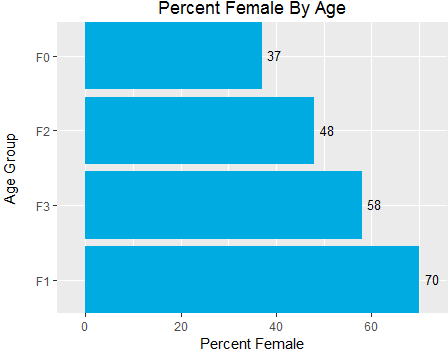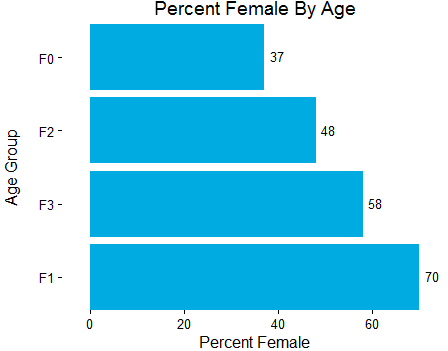The goal is to get rid of the space between the tick marks and the base of the bars without cutting off any of the percentage labels beyond the other end of the bars.
I am running dozens of bar graphs using R's ggplot2 and trying to follow our organizational style guide, which was developed using Excel manually for each graph. The maximum length bars are of different lengths in the different graphs and could change as the source data changes, so I don't want to manually set limits. [Perhaps there is a workaround here: is there a way to automatically adjust limits depending on the input?]
I have already consulted:
Removing negative plot area in ggplot2
How to remove space between axis & area-plot in ggplot2?
Force the origin to start at 0 in ggplot2 (R)
http://docs.ggplot2.org/dev/vignettes/themes.html
A graph which almost works is generated from the following code. For public purposes I'm using the "quine" dataset from the MASS package. First I find percentages female by age grouping. Then I order the age groups by percentage female.
require(MASS)
attach(quine)
p.SexAge <- prop.table(table(Sex, Age), 2)
perc.SexAge <- round(p.SexAge * 100)
perc.SexAge.flattened <- as.data.frame(perc.SexAge)
perc.SexAge.flattened.F <- subset(perc.SexAge.flattened, Sex == "F")
require(ggplot2)
ggplot(data=perc.SexAge.flattened.F, aes(x=reorder(Age, -Freq), y=Freq)) +
geom_bar(stat="identity", fill = "#00ABE1") +
scale_x_discrete(expand = c(0, 0)) +
scale_y_continuous(expand = c(0,6)) +
ggtitle("Percent Female By Age") +
ylab("Percent Female") +
xlab("Age Group\n") +
#theme_classic() +
theme(plot.margin = unit(c(0,0,0,0), "in")) +
coord_flip() +
geom_text(aes(label = Freq), vjust = 0.4, hjust = - 0.4, size = 3.5)
When theme_classic() is uncommented to create empty white space to satisfy our style guide, it is clear that there is excessive space between the vertical axis tick marks and the base of the bars. This problem gets much worse if there are more bars (not shown).
If I change scale_y_continuous(expand = c(0,6)) to
scale_y_continuous(expand = c(0,0)),
the label gets chopped off on the longest bar,
violating the organizational style guide.




